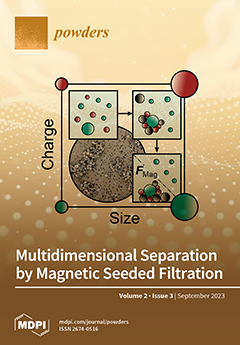The understanding of granule growth mechanisms and the effects of formulation and operating conditions over product quality and process performance in fluidized bed co-melt granulation is nowadays of great interest. In this sense, this work systematically studies the combined effects of binder content (W
PEG) and fluidization air flowrate (F
A) and temperature (T
A) on granules’ quality and process-related variables (product mass (M
P), elutriated fines (M
f), mass stuck on walls (M
W)) by using a Box–Behnken-type design of experiments (DoE), as it is a statistical tool suggested by the Quality by Design (QbD) initiative. It was found that the granules’ size and powder flowability are significantly affected by W
PEG (higher W
PEG, higher granule size and better flowability). Interestingly, T
A is the process variable that significantly affects M
P, enhancing process performance at high temperature values. Regarding F
A, it significantly affects d
10, promoting the formation of small particles due to breakage at high flowrates and the presence of non-elutriated powder at low flowrates. As a consequence, intermediate F
A is the optimum for obtaining higher M
P. Regarding regime map studies, most runs experienced a rapid growth regime, which is in accordance with the granules’ high pore saturation. This result agrees with the observed high increment in particle size and the morphology of the final granules, allowing researchers to validate and extend existing previous maps.
Full article



